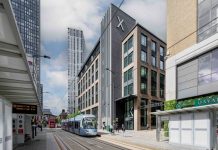UK institutions have been the most prominent investors in the Birmingham office market, accounting for over 58% of the value of transactions in 2015, according to the latest Who Owns Central Birmingham report.
Now in its fifth year, the annual study, which is published by leading property adviser, Bilfinger GVA, provides a unique insight into the profile of Birmingham’s commercial property ownership across 15 million sq ft of office and retail property in the city’s central business district.
Birmingham once again saw a remarkable level of activity over 2015, with some £992 million transacted across both the office and retail sectors, up from £645 million in 2014.
While overall ownership from UK-based organisations fell by 1% over the last 12 months to 70%, ownership from local Birmingham-based occupiers has seen a significant rise, up from 1% in 2014 to 9%.
As in previous years, overseas investment activity has remained strong – with the amount of overall foreign ownership increasing from 29% to 31% – however there was considerable movement, with Middle Eastern and mixed UK and overseas investors increasing holdings from 2% to 5% and 8% to 12% respectively. Far Eastern investor interest remained flat at 1% of total stock.
Ownership by European investors increased by 6% to 7%, with the majority of European investment coming from German funds, who are now holding 935,000 sq ft of space. This includes the £130 million acquisition by German fund VGV of RBS’ Brindleyplace headquarters in central Birmingham and GLL Real Estate’s circa £37 million purchase of 1 Brindleyplace.
The city’s largest single commercial deal, however, was Ashby Capital’s acquisition of the landmark Colmore Plaza building from US private equity group, Carlyle for £138 million on behalf of a Middle Eastern buyer.
Ian Stringer, Regional Senior Director, said: “Birmingham remains an attractive proposition for both domestic and foreign investors, particularly with ongoing capital investment projects such as the extension to the Midland Metro and the recently completed redevelopment of New Street Station and the Grand Central shopping centre.
“Looking ahead, 2016 has the capacity to provide a number of exciting opportunities within the city, underpinned by the recent acquisition of 50% of Hermes Investment Management’s stake in the Paradise redevelopment to CPPIB.
“With ongoing demand, the market will likely face under-supply of good quality space until better quality refurbished schemes such as Bruntwood’s 110,000 sq ft 2 Cornwall Street, and IM Properties’ 160,000 sq ft 55 Colmore Row, bring new high quality stock to the market in late 2016 and early 2017 respectively.”
Grade A stock in overseas ownership is up from 46% to 49%, while Grade B properties have fallen from 11% to 5%.
This activity is against a strong national backdrop of activity, with total value of investment transactions reaching a record high in excess of £70 billion.
Barry Riley, from the Investment team at Bilfinger GVA, said: “It is little surprise that trophy Grade A assets remain the most appealing to the vast majority of overseas capital, however the ongoing redevelopment and refurbishment of sub-prime stock is continuing to pique interest from UK-based organisations.
“Birmingham is reflecting the national investment market, where overseas buyers accounted for 50% of the value of UK purchases in 2015, with US and Far East buyers the most active, acquiring commercial stock worth £20 billion.
“While the national market remains heavily influenced by activity in London, 2015 also saw significant weight of money transacted in the regional markets, driven primarily through improved confidence in occupational markets and the ongoing pricing-out of investors from London and the south east.
“This is continuing to place downward pressure on prime yields, which are now in the 5%-5.25% range for the largest regional cities. Total returns in the regional markets were down circa 14% for offices and 8% for high street retail, demonstrating extremely strong levels of performance.”
Within the retail sector, 2015 saw the completion of the £150 million Grand Central, anchored by a 250,000 sq ft John Lewis department store, with Hammerson entering into a joint venture agreement with Canadian Pension Plan Investment Board (CPPIB) for ownership of Grand Central for £335 million.
There has also been significant investment in the wider Birmingham retail offer, with a £50 million redevelopment of the Mailbox, which has doubled the size of Harvey Nichols, and Selfridges receiving a £20 million refit to its premises at the Bullring. Birmingham is now the only city outside of London to have a Selfridges, Harvey Nichols and a John Lewis.
Transactional activity was underpinned by British Land’s sale of the 490,000 sq ft House of Fraser building in central Birmingham to Legal & General for £71 million, with other activity including the sale of Martineau Place to Colony Capital as part of the £311 million Gemini portfolio, and Orchard Street Investment’s acquisition of the Exchange Buildings on New Street for £40 million.





















